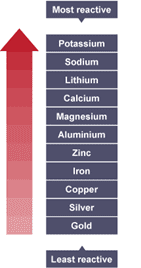In this post
A reactivity series is a list which places metals into an order of their reactivity. Reactivity of metals is determined by the number of electrons they need to lose to achieve the stability of a full outer shell, how easy it is for them to lose these electrons, and the nature of the other substances with which they are reacting.
Some metals have a greater tendency to lose their electrons and are said to be very reactive. Some metals have a much lower tendency to lose electrons and are said to be relatively unreactive. In a reactivity series, the most reactive metals are put at the top of the list and the least reactive at the bottom.
The arrangement of the metals in a reactivity series is based on observations made during their chemical reactions with water and dilute hydrochloric or sulphuric acid, as well as displacement reactions between metals and their oxides and metals and aqueous solutions of metal salts.
Reactions between metals and water
To test the reactivity of metals with water, a small piece of metal is added to some cold water and the observations recorded. Most metals when added to water will not react or will react so slowly that you would have to monitor them for days or weeks to see any difference.
We have already seen that the alkali metals lithium, sodium and potassium do react with water to produce hydrogen gas and an alkaline solution of metal hydroxide. Calcium will also react with water in a slow reaction where calcium hydroxide is produced. The reaction between calcium and water is much slower than between lithium and water. The more vigorously the metal reacts, the higher up the reactivity series it should be placed.
The order of reactivity of these four metals with water from most to least reactive is:
- potassium
- sodium
- lithium
- calcium
Reactions between metals and dilute acids
If the metal does not react with water, a small piece can be added to a small volume of dilute hydrochloric acid or dilute sulphuric acid. The observations made show us where in the reactivity series the metal should be placed.
Metals which do react with water are more reactive than those which will not. Metals which react with acids produce a metal salt and hydrogen gas. The piece of metal dissolves into the acid producing a solution of the metal salt and hydrogen gas. The rate of the reaction for each metal can be compared by looking at the rate at which the bubbles are produced and the length of time taken for the metal to dissolve into the acid.
The reactivity comparisons are shown in the table below:
| Element | Reaction with acid |
| Calcium | Very quickly |
| Magnesium | Quickly |
| Zinc | More slowly |
| Iron | Slower still |
| Copper | Very slow |
| Silver | Barely reacts |
| Gold | Does not react |
Displacement reactions
A displacement reaction is one in which a more reactive metal takes the place of a less reactive metal in a compound. A displacement reaction will only occur if the metal being added is more reactive than the one which is currently in a compound.
One type of displacement reaction which can be used to determine the positions of metals in the reactivity series is the reaction between metals and metal oxides. For example, a displacement reaction would not happen if magnesium was added to calcium oxide as the magnesium is less reactive than the calcium and would not be able to take its place.
However, if potassium was added to calcium oxide, a displacement reaction would take place as potassium is more reactive than calcium and is able therefore to take its place. Another type of displacement reaction which can be used is the reaction between metals and aqueous solutions of metal salts. For example, if aluminium was added to zinc chloride, a displacement reaction would occur where the aluminium would replace the zinc, forming aluminium chloride and zinc metal. This shows that aluminium is more reactive than zinc. If copper was added to iron(III) chloride solution, no changes would be observed. The copper is less reactive than iron so no displacement reaction would occur.
When the observations from all of these reactions are combined, the metals can be placed into the reactivity series in order of their reactivity. You must know the order of reactivity of the metals as shown in the diagram below:

Potassium is the most reactive metal on the reactivity series and gold is the least reactive metal.



